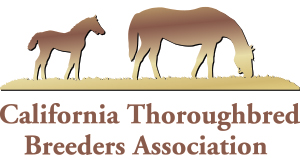By Tracy Gantz, The BloodHorse
BONSALL, Calif. (July 18, 2016) – Edward Freeman and Square Eddie have parlayed English experiences into California success. As part of Paul and Zillah Reddam’s booming operation, the trainer and the stallion are quietly building reputations, the man guiding the sire’s offspring through their early paces at San Luis Rey Downs in Bonsall, Calif.
While Nyquist and the O’Neill brothers (Doug and Dennis) have quite naturally dominated headlines for Reddam Racing from last year’s Breeders’ Cup through this year’s Triple Crown trail, Freeman and Square Eddie’s names appear frequently in California race results. Freeman, a public trainer who also does substantial work for the Reddams, has trained stakes winners More Complexity and Sprouts, both by Square Eddie, and he has put in the foundation on the progeny of Square Eddie trained by others.
“Edward has clearly done an excellent job over the years,” said Paul Reddam. “He’s a hands-on guy, and he’s very bright. He’s very caring about the horses, and, like most horse trainers, he’s an extreme optimist.”
Freeman and Square Eddie (Smart Strike-Forty Gran, by El Gran Senor) began their careers in England, though Canada may demand a bit of credit. The son of a Grand National-winning steeplechase jockey, Freeman, now 56, grew up in Newmarket and worked for Mike Doyle and Roger Attfield in Canada before landing in California. Square Eddie, now 10, is, like Reddam, a Canadian-bred. His initial four starts in England attracted the attention of Jamie McCalmont, the Reddams’ English agent.
In his first start for the Reddams, Square Eddie powered home by 4 ¾ lengths in the 2008 Lane’s End Breeders’ Futurity (GI) at Keeneland. The colt joined Doug O’Neill’s barn in California and ran second to Midshipman in the Bessemer Trust Breeders’ Cup Juvenile (GI).
Square Eddie impressed Freeman in 2010, when the 4-year-old colt rehabbed from an injury at Vessels Stallion Farm near San Luis Rey, and Reddam decided to breed some mares to him.
“We picked him up every morning, took him to San Luis Rey to train him, and took him back to breed him,” said Freeman. “There aren’t too many stallions you can do that with.”
One day Square Eddie lost his rider during training. He headed toward Freeman, who had visions of being run over. Instead, Square Eddie cantered straight to the trainer and stopped.
Square Eddie returned to racing in O’Neill’s barn the following year, and set a 6 ½-furlong track record of 1:13.11 at Santa Anita that still stands.
“I remember that day being just gob-smacked,” said Freeman.
The foals began arriving the following year. Mares with some racing ability but without graded stakes wins or top-quality pedigrees turned out the likes of $341,265-earner Smoove It, $233,470-earner More Complexity, $207,440-earner Sprouts from his first crop. The stallion’s 2013 roster included 2015 Hopeful Stakes (GI) winner Ralis, two-time stakes winner Found Money, and 2015 Graduation Stakes winner Mrazek, who most recently annexed the July 4 Thor’s Echo Handicap.
“His yearlings are remarkably correct,” said Freeman.
Reddam admist Square Eddie has “never had a real quality book of mares” because Reddam Racing’s business model has been to sell its top racemares at auction.
“The thing that really stands out about Square Eddie is that he has lifted what one could expect from there mares,” said Reddam.
Freeman starts all of the Reddams’ Square Eddie youngsters. They can end up in Freeman’s barn, though some have gone to O’Neill, the Reddam’s primary trainer, and Ben Cecil.
With Square Eddie standing at Vessels, now called Ocean Breeze Ranch, nearly San Luis Rey Downs provides an ideal place for Freeman to train the 2-year-olds.
“One of the good things about San Luis Rey is that it’s a proper track,” said Freeman. “There are horses going the wrong way and all of the things that you’ll see at Santa Anita. But there are only 400 horses.”
Because San Luis Rey doesn’t conduct racing, once morning training hours have ended, it is even quieter for 2-year-olds. That allows Freeman more flexibility in his training, something that suits a person whose first training experiences came in England.
In fact, Freeman initially learned more about older horses, since steeplechasers begin their careers later than flat racers. His father, Arthur Freeman, won the 1958 Grand National aboard Mr What and also rode for the Queen Mother.
Young Edward, who to this day goes by the British Edward rather than the more American nicknames of Ed or Eddie, followed his father into steeplechase riding for a while as an amateur, though he readily admits, “I wasn’t very good.”
Edward and his buddies would look at the entries for horses that didn’t yet have a rider.
“We’d find horses that had terrible records, like ‘fell, fell, pulled up,’” Freeman said.
Calls to the owners sometimes elicited a mount, usually after the owners overcame their astonishment that anyone would seek to ride such animals.
Freeman eventually followed a more conventional path, obtaining a degree as a civil engineer. But he hates the work. When his firm offered him an 18-month job in the Falkland Islands to rebuild the airfield after the Falklands War, Freeman recalls asking his boss one question: “Do you need a month’s notice or can I leave in two weeks?”
He spent five years working for trainer Jimmy FitzGerald, an Irish horseman Freeman calls “a genius.” It wasn’t a lucrative way to earn a living, and so in 1987 Freeman and a friend decided to take a trip around the world.
“We sold everything we had, and the only tickets we could afford were to Toronto,” said Freeman. “Some people in Australia are probably still waiting for me to show up.”
Toronto proved an excellent place for Freeman to learn training from Doyle and Attfield. In his second year on his own, Freeman became a private trainer for George Frostad, the father of trainer Mark Frostad.
Later as a public trainer, Freeman headquartered at Fort Erie. Attfield sent his 2-year-olds to Freeman for their early lessons.
“Roger had a lot of really nice horses, and it was a fantastic experience,” said Freeman. “Watching young horses develop is very rewarding.”
Those horses included Strawberry Reason, a graded stakes winner who produced champion Vindication; and L’Carriere, who began his career for Attfield and later finished second to two-time Horse of the Year Cigar in the 1995 Breeders’ Cup Classic (GI).
A disadvantage to training in Canada is the necessity of finding a place to winter. A side job with Luke Lillingston and Lincoln Collins first took Freeman to California, when those agents were brokering the sale of such horses as eventual Eclipse Award winner Golden Apples.
California and its good weather beckoned, and in 2004 Freeman took eight horses to San Luis Rey. Though he didn’t have much success with them, he met McCalmont, who also had grown up in Newmarket and had gone to school with Freeman’s youngest brother.
McCalmont, working for the Reddams, was looking for someone to break youngsters by Momentum. The Reddams stood the grades stakes-winning son of Nureyev at Vessels.
For a couple of years, Freeman wintered in California, starting Momentum’s offspring, and returned to Canada to train in the summers.
“It became tougher and tougher to lock the house on the beach and go back to Canada,” said Freeman, who now lives year-round in Oceanside, a beach community north of Del Mar and west of San Luis Rey.
When Momentum didn’t prove a success at stud, the Reddams bred the mares that stallion had been getting to Square Eddie, with Freeman then starting that stallion’s offspring.
“They’re a good combo because Edward has a core belief that any Square Eddie can run,” said Reddam. “That’s obviously not true, but starting with that belief, he gives horses more of a chance than others might.”
About mid-year Freeman and the Reddam team assess the yearlings, starting the horses earlier than many others do. Freeman fives the horses their initial lessons at Ocean Breeze and then turns them back out in the farm’s pastures to grow.
“We want to give them all a chance to be 2-year-olds,” said Freeman.
Freeman will usually divide the yearlings into four groups – precocious ones that could take advantage of early 2-year-old races, the potential stars, the ones whose birthdates or bottom lines dictate waiting, and then the rest. He starts the first group in July.
“We give them a month,” he said. “They’ll be ridden, walked, and not much more.”
After their turnout time, Freeman sends the horses to Scott Hansen at Gary Broad’s Oakmont Ranch in nearby Murrieta. They learn the essentials of galloping on that training track until the time that San Luis Rey allows in 2-year-olds.
“The problem with 2-year-olds is they are growing machines that are designed to run,” said Freeman. “I’m trying to stress their joints and bones, particularly shins, through that period just enough to build up density and build up strength but not enough to buck shins and cause them to have lots of time off.”
Freeman believes in plenty of foundation, driving youngsters on the ground, teaching them steering with figure-eights, and getting them to relax by such things as walking back to the barn on a long rein.
The system works. Square Eddie had 22 2-year-olds for the Reddams in 2015. Freeman said that 14 of them ran as 2-year-olds and 10 of those won – Ralis, Mrazek and Found Money among them. With the bonus paid to California-breds who win maiden special weight races, the program has done particularly well.
Freeman declines to take much of the credit, deflecting it to the Reddam team and to Square Eddie. Reddam, however, notes the key role Freeman plays.
“A lot of that is certainly Square Eddie, but it’s also Edward,” said Reddam. “The program is complete dependent upon him. He’s the unsung hero behind the scenes because many of the horses that he starts go to Doug. It’s all the high school coaching that makes the college athlete. Obviously, Edward and Doug are both contributors to the horses’ success.”
Freeman instills the philosophy into his help that Square Eddie’s success reflects well on them.
“I want to encourage them to feel good when the horses win, even when they don’t win for us,” he said. “Green With Eddie won the other day impressively at Santa Anita (for O’Neill), and the next day the guy who rubbed him had a big smile on his face.”
Freeman also breeds a few horses, and he sits on the California Thoroughbred Breeders Association board of directors. He owns two mares and has an interest in three others.
“I believe that if Square Eddie gets mares with proper stamina, which is quite difficult to find these days, he might produce any kind of horse,” said Freeman.
At the 2016 Keeneland January sale, Freeman purchased Lunar Dimension, a 4-year-old daughter of Malibu Moon out of stakes winner Alexander Three D. While Lunar Dimension started only once, her dam, a half sister to Golden Apples, “stayed a mile and three-quarters,” according to Freeman.
Freeman’s steadfast belief in Square Eddie’s ability not only helps the trainer give the Reddam homebreds a good start, but could ultimately lead man and sire to classic success together.


